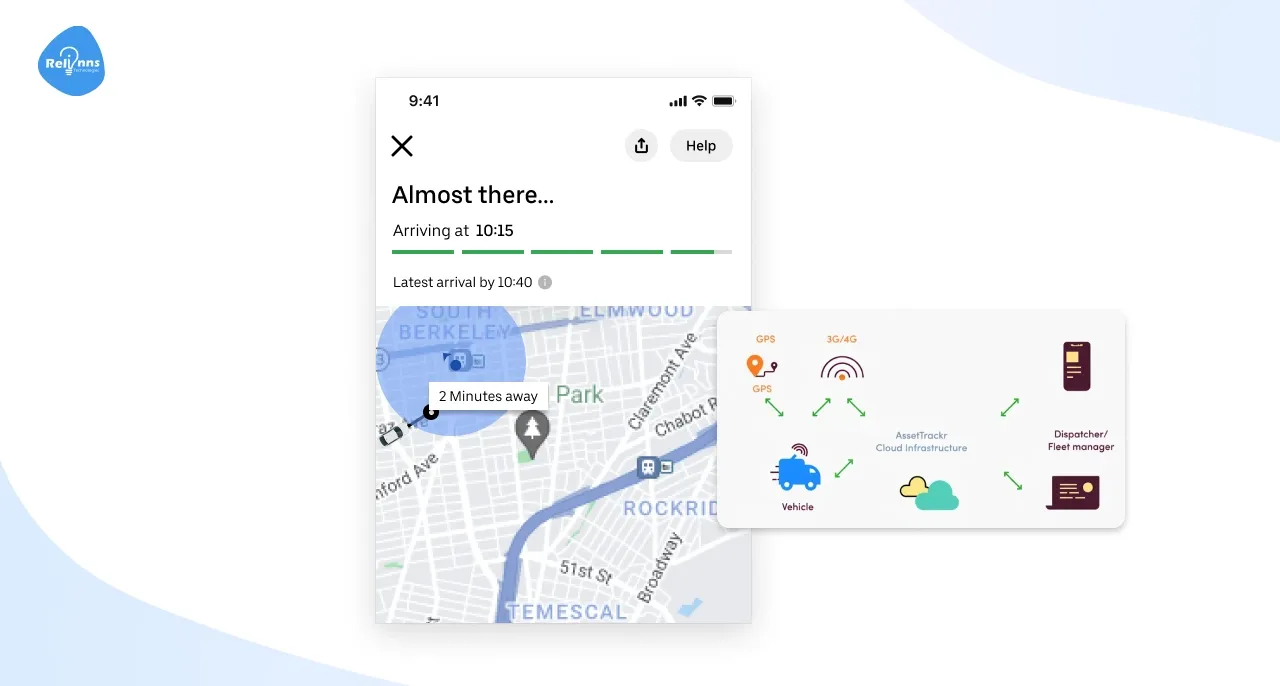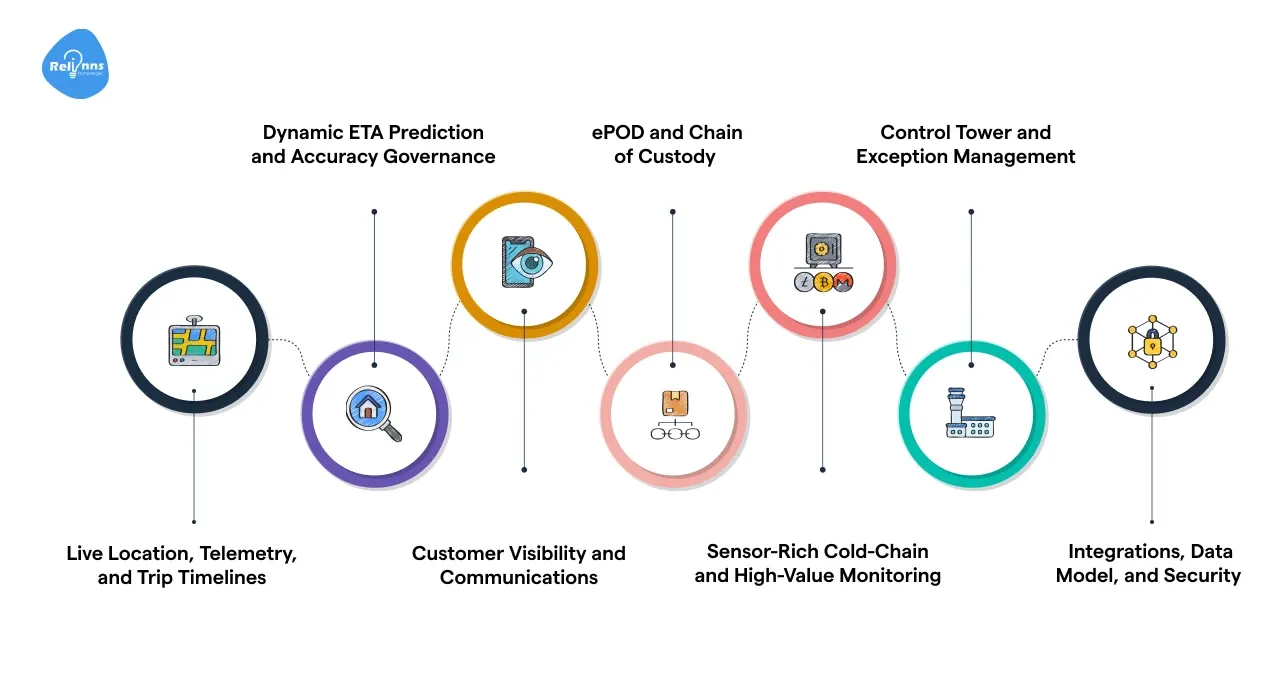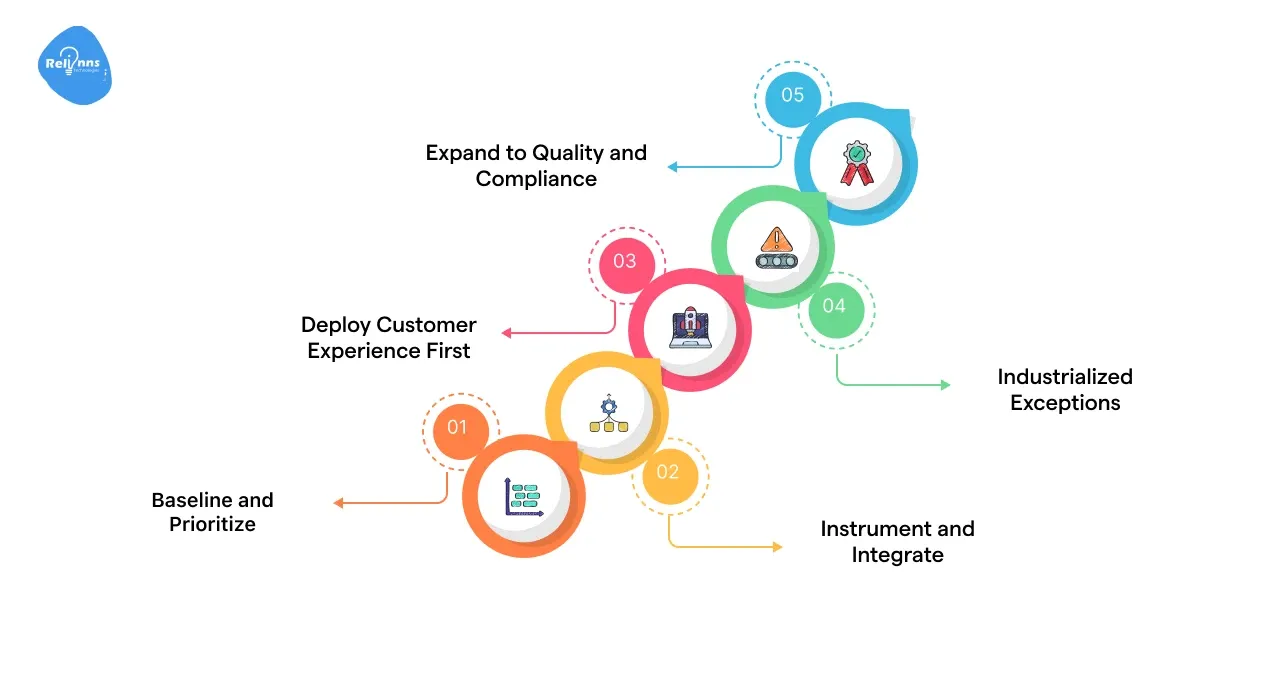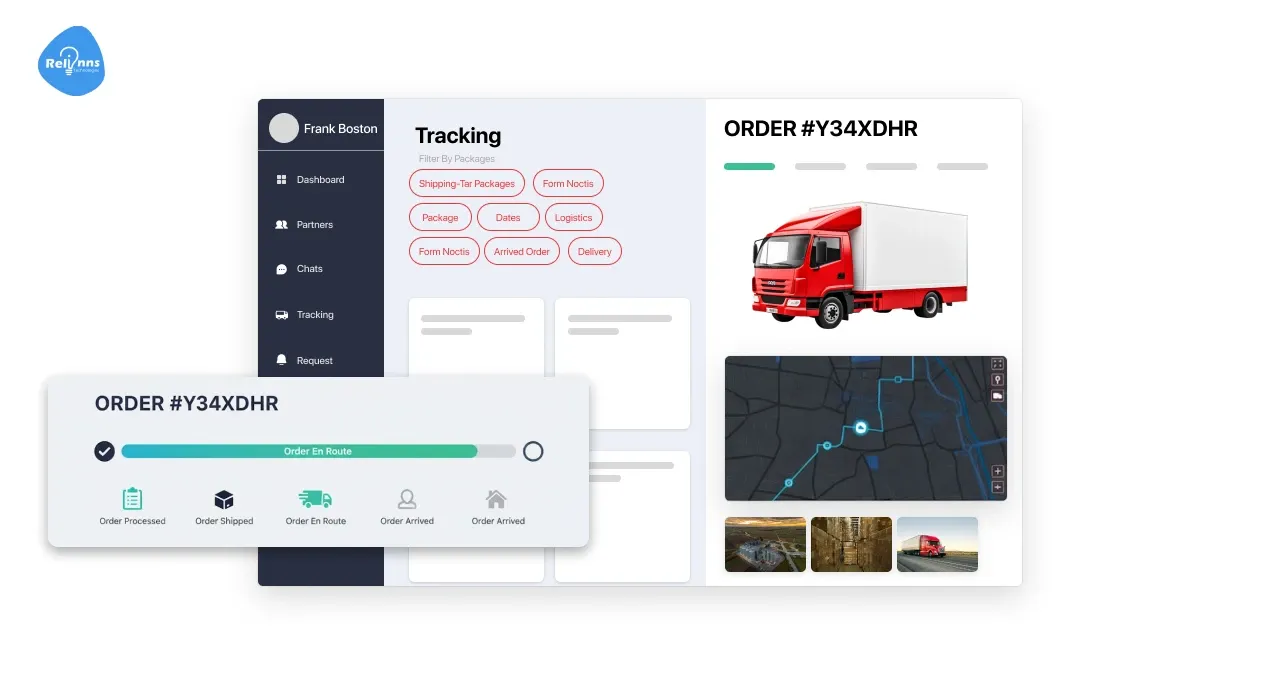Real Time Logistics Tracking Solutions: Transforming Delivery Visibility in 2026
Date
Nov 11, 25
Reading Time
7 Minutes
Category
Enterprise Solutions
Late updates, vague ETAs, and missed delivery windows frustrate customers and create expensive “where-is-my-order” overhead.
As parcel volumes rise, operations leaders need live visibility, not lagging indicators.
This guide explains Real-Time Logistics Tracking Solutions, maps every feature of a modern logistics tracking system, and shows how real time freight tracking, retail logistics tracking, and real time logistics capabilities reduce costs while lifting service levels.
What “Real-Time” Means in 2026 (and Why It Matters)

True real-time goes beyond scan events. It streams live GPS, sensor data, and ETA predictions to everyone who needs them, from control towers to end customers.
Recent consumer research shows buyers now expect continuous, accurate order visibility and fewer WISMO contacts, tying tracking directly to loyalty and repeat purchase.
Key takeaways: live location and dynamic ETAs reduce uncertainty, improve first-attempt success, and cut support load. In maritime and inland chains, ETA accuracy has become a strategic differentiator, not a dashboard metric.
Core Capabilities of Real-Time Logistics Tracking Solutions

Before the bullets, here’s the big picture: modern Real-Time Logistics Tracking Solutions unify data from telematics, driver apps, carrier APIs, and warehouses.
The platform converts raw signals into customer-facing milestones and ops workflows. Below are the feature areas your logistics tracking system should cover end-to-end.
1. Live Location, Telemetry, and Trip Timelines
Continuous GPS, along with engine and sensor data, creates a trustworthy “trip narrative” that everyone can follow. Compare actual paths to plans, trigger exceptions automatically, and feed data to ETA engines to support proactive decision-making.
- Continuous GPS with geofences that raise entry/exit and dwell events.
- Engine fault codes and battery state are streamed for risk and delay alerts.
- Stop-level breadcrumbs build auditable driver and vehicle timelines.
Why it matters: Carrier and postal programs emphasize instant map views and OTP-secured handoffs to shrink uncertainty and increase confidence in last-mile flows.
2. Dynamic ETA Prediction and Accuracy Governance
ETA quality drives NPS, staffing, and dock schedules. Leaders calibrate prediction models by lane and asset type, then publish confidence ranges to customers and ops.
- ML models blend traffic, weather, historical dwell time, and driver profiles.
- Confidence scoring highlights risky ETAs and auto-triggers comms.
- Exception playbooks reschedule, re-route, or escalate resources.
Why it matters: Academic and industry analyses stress ETA precision as a competitive lever across maritime and inland legs.
3. Customer Visibility and Communications
Consumers want more than “out for delivery.” Modern real-time logistics views show live map position, stops-before-you, and narrow delivery windows to cut WISMO tickets.
- Day-of-delivery live map with dynamic time windows.
- Branded notifications across SMS, email, and app pushes.
- Proactive delay explanations and re-slotting options.
Why it matters: European tracking studies define this tier as “advanced real-time,” showing live location and next stops to set expectations. Mobile OS updates are also standardizing this live experience.
4. ePOD (Electronic Proof of Delivery) and Chain of Custody
Proof drives cash flow, claims, and compliance. ePOD closes the loop with signatures, photos, time-stamps, and conditions captured in the moment, then synced to billing and CRM.
- Signature, photo, timestamp, geofence, and condition notes.
- Contactless options with OTP and policy checks.
- Instant document sync to billing, claims, and support.
Why it matters: ePOD adoption and markets are expanding rapidly, reflecting its role as the backbone of modern logistics handoffs.
5. Sensor-Rich Cold-Chain and High-Value Monitoring
Pharma, grocery, and electronics need more than a position. Temperature, shock, tilt, and humidity turn tracking into quality assurance.
- Live temperature curves with excursion alerts and audit trails.
- Shock and tilt detection for fragile SKUs and returns decisions.
- Lane analytics to pick carriers and packaging that protect quality.
Why it matters: Cold-chain monitoring is scaling fast through 2030, and temperature-integrated visibility is now core to compliance and waste reduction.
6. Control Tower and Exception Management
Control towers should be action centers. Operators need noise reduction, intelligent prioritization, and guided playbooks that automatically trigger tasks and messages.
- Ranked exception queues with time-to-breach indicators.
- Auto-spawned tasks for reslotting, re-routing, or customer options.
- Closed-loop outcomes feed model retraining and SOP improvements.
Why it matters: Peer-reviewed and industry reports tie real-time control towers to measurable efficiency and CSAT gains.
7. Integrations, Data Model, and Security
A logistics tracking system is only as strong as its integrations. Choose platforms with open APIs, strong webhooks, and role-based governance to avoid information sprawl.
- Prebuilt connectors: TMS, WMS, OMS, ERP, carrier networks.
- Event streams for low-latency updates and customer experiences.
- RBAC, audit trails, and signed evidence for regulators and insurers.
Why it matters: National and global logistics benchmarks now incorporate big-data shipment timing, so your data quality is strategic, not optional.
Solution Architecture: From Signal to Experience
A clean architecture keeps latency low and ETAs honest. Think streams in, decisions in the middle, and experiences out.
- Ingest: telematics, driver apps, carrier EDI/API, parcel scans, IoT sensors.
- Decisioning: ETA engines, rules, and ML for exceptions and comms.
- Experience: control-tower UI, customer portals, partner dashboards, and notifications.
Mobile UX matters. OS-level live-tracking surfaces on Android normalize the “glanceable” ETA experience for food, rides, and parcels, raising consumer expectations across categories.
Implementation Playbook for Real-Time Logistics Tracking Solutions

Implementing a robust real-time logistics tracking solution requires precision, phased rollouts, and measurable benchmarks.
The following implementation playbook outlines best practices for integrating a logistics tracking system that supports real time freight tracking and retail logistics tracking at scale.
1.) Baseline and Prioritize
Start by mapping WISMO volume, first-attempt delivery rates, dwell hotspots, and lane variability. Align KPIs to customer outcomes and operational costs, then pick one or two high-impact pilots, such as live ETA plus ePOD.
Do next: Quantify WISMO savings, set ETA accuracy goals by lane, and define exception SLAs tied to alerts.
2.) Instrument and Integrate
Connect GPS, sensors, and carrier APIs. Normalize identifiers across orders, legs, and partners. Decide on your system of record for stops and events to avoid double entry and churn from discrepancies.
Do next: Deploy webhooks, ensure RBAC and audit trails, and test latency end-to-end.
3.) Deploy Customer Experience First
Launch a branded tracking page with a live map and “stops before you.” Pair with dynamic ETAs and honest delay comms to reduce calls immediately.
Do next: Measure NPS change, WISMO deflection, and first-attempt success.
4.) Industrialized Exceptions
Build playbooks for the top five disruptions: late departure, capacity shortfalls, cold-chain excursion, failed first attempt, and address issues.
Do next: Auto-spawn tasks and messages, log outcomes for weekly reviews.
5.) Expand to Quality and Compliance
Layer in ePOD, photo evidence, and condition capture. For cold-chain or fragile items, add temperature and shock traces to the same trip narrative.
Do next: Connect billing and claims to accelerate cash and reduce disputes.
Real-World Use Cases for Real-Time Logistics Tracking Solutions
Every logistics leader wants proof that transformation delivers measurable value.
These real-time logistics tracking solutions showcase how companies applied logistics tracking systems, real time freight tracking, and retail logistics tracking to boost transparency, efficiency, and customer trust across complex delivery networks.
A.) National Postal Network, India — APT 2.0 Last-Mile Modernization
Problem: A legacy last-mile network faced long queues, slow counters, and poor parcel transparency. Customers lacked reliable real-time tracking and secure handoff. Staff dealt with fragmented systems for payments, stamps, and parcels, which limited throughput and undermined confidence in delivery timelines.
Solution
- Unified digital platform with real-time parcel and mail tracking.
- OTP-secured deliveries plus digital payments to accelerate counters.
- Integrated services into one user-friendly interface for staff.
- Lowered transaction times with streamlined workflows and data sharing.
- Improved transparency with a consistent event updates system-wide.
Results
- Faster service at counters, thanks to integrated payments and unified digital workflows.
- Higher customer confidence, real-time tracking, and OTP handoff strengthened transparency.
- Shorter queues observed, transaction times reduced through standardized processes.
- Fewer status inquiries, better self-service visibility via live tracking features.
Use Case Reference: Times of India coverage of APT 2.0.
B.) Global E-commerce Leader — Assisted Driving and “Last 100 Yards”
Problem: Rapid delivery expansion required shaving minutes from the final approach. Handhelds slowed down scanning, navigation, and photo proofs. Variability in new driver performance created missed windows, inconsistent ETAs, and added route friction, reducing the predictability of dense urban deliveries.
Solution
- Smart driver eyewear unified navigation, barcode scans, and delivery photos.
- Hands-up interface reduced device juggling and kept eyes on the path.
- Swappable batteries supported full shifts without downtime.
- Data fed live ETAs and post-route analytics.
- Program scaled across routes on an optional, no-cost basis.
Results
- Up to 30 minutes saved per driver shift, from streamlined last-yard actions.
- Higher first-attempt success, faster evidence capture, and improved doorstep handoffs.
- More accurate ETAs, in-route telemetry, and tightened customer windows dynamically.
- Fewer safety incidents, eyes-forward guidance reduced distraction risk significantly.
Use Case Reference: Reuters logistics technology report.
Measuring Success in Real-Time Logistics Tracking Solutions

Pick a compact scorecard and socialize it.
Recommended metrics: ETA MAPE by lane, first-attempt success, WISMO deflection, ePOD latency to invoice, excursion minutes per thousand cold-chain stops, and exception time-to-resolution.
Remember: visibility without workflows is noise.
Visibility with guided actions is leverage.
Governance, Security, and Compliance for Real-Time Logistics Tracking Solutions
A modern logistics tracking system carries sensitive locations, identities, and evidence.
Secure by design: enforce RBAC, encrypt in transit and at rest, and log every event in an immutable trail. Align retention with policy and regulator needs, and review access routinely.
Checklist
- Rotate Credentials
- Segregate Environments
- Throttle Webhooks
- Test Failover Paths
- Version Workflows
Conclusion: Implementing Real-Time Logistics Tracking Solutions with Relinns
Real-time visibility isn’t just a customer convenience—it’s the foundation of modern logistics excellence. From automated alerts to predictive ETAs, real-time logistics tracking solutions redefine how companies control costs, manage assets, and enhance customer trust.
That’s where Relinns Technologies steps in. As an innovation-driven partner in workflow and automation, Relinns empowers logistics companies to implement real-time freight and retail logistics tracking, as well as unified visibility platforms tailored to their operations.
Why Choose Relinns?
Relinns specializes in low-code, scalable automation built for logistics and mobility sectors. They can design custom logistics tracking systems to ensure smooth implementation, faster ROI, and measurable business impact.
- 42% faster deployment of logistics automation workflows across multiple delivery networks
- 29% reduction in operational overhead through unified tracking and route optimization
- 37% improvement in delivery ETA accuracy with predictive analytics and real-time data feeds
- 98% customer satisfaction rate achieved through transparent, automated tracking experiences
Relinns turns complex logistics challenges into connected, data-driven ecosystems — helping you deliver smarter, faster, and with confidence.
Frequently Asked Questions (FAQ's)
How does real-time logistics tracking improve delivery transparency?
By using a logistics tracking system, companies can provide live location, ETA updates, and proof of delivery in real time, helping improve customer trust and reduce inquiry volumes.
What industries benefit most from real time freight tracking?
Sectors like retail, e-commerce, pharmaceuticals, and manufacturing rely heavily on real time freight tracking to optimize routes, ensure product safety, and meet strict delivery timelines.
How can retail logistics tracking improve last-mile efficiency?
Retail logistics tracking automates dispatch, reduces idle time, and provides visibility into every shipment stage, cutting last-mile delays and boosting delivery accuracy for retailers.
What are the biggest challenges in adopting real-time logistics systems?
Integration complexity, data synchronization, and hardware compatibility are common. However, real time logistics platforms today use APIs and IoT integration to overcome these barriers easily.
Can small logistics providers afford real-time tracking solutions?
Yes, modern real-time logistics tracking solutions offer modular pricing, allowing smaller logistics firms to start with essential features and scale as their operations expand.
How do real-time logistics platforms enhance ROI for delivery businesses?
With automated logistics tracking systems, businesses report lower operational costs, fewer failed deliveries, and better route utilization, driving ROI within the first year of implementation.


